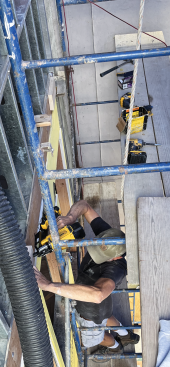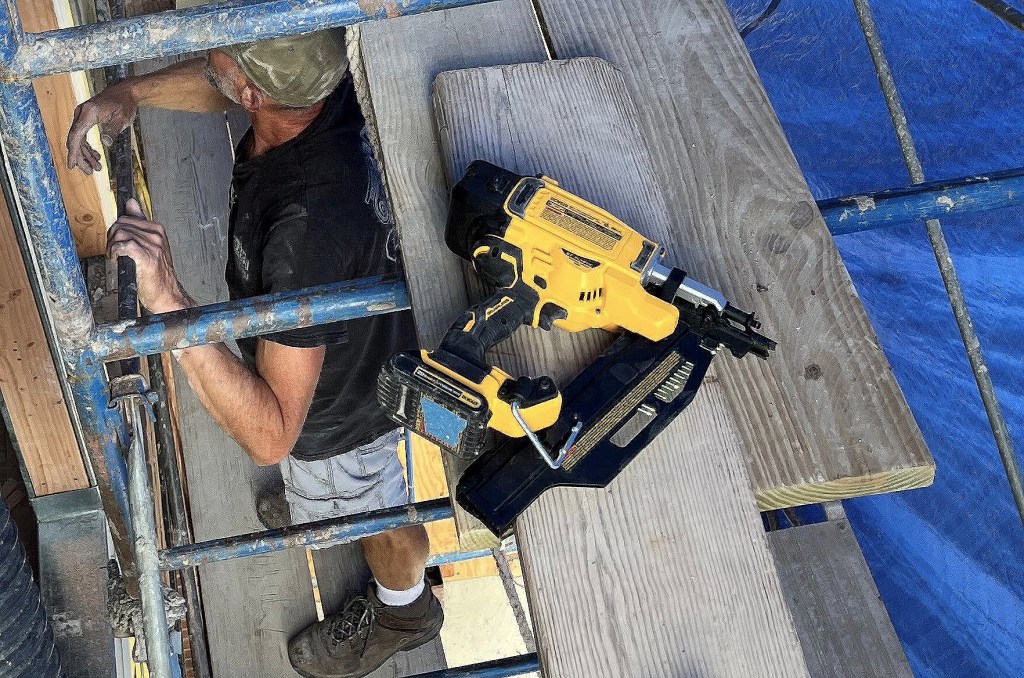In tight urban spaces, where I do a lot of work, compressors and hoses for pneumatic tools can be difficult to maneuver and even hazardous. So, I was excited to test the DeWalt DCN920 cordless framing nailer, a 20-volt, brushless, 21-degree gun weighing 10 pounds (with battery) that drives plastic collated stick nails from 2 to 3½ inches. Our kit contained the gun, a 5-Ah battery, charger, belt hook, no-mar tip, and kit bag (it’s also available gun only). We loved that the battery and charger are interchangeable with our other DeWalt 20-volt tools. DeWalt also offers the DCN930, a 30-degree, paper-tape cordless unit.
A month after receiving the nailer, we started a renovation on a four-story attached home in a high-density city neighborhood. The project included an addition off the back that required a variety of framing tasks, including walls, joists, rafters, roof decking, and subfloors—a perfect trial for the gun. The crew was used to pneumatics, but the DeWalt scored points right out of our truck: Grabbing one bag versus grabbing a gun, compressor, and hose was a pleasure in a town where parking spots in front of the job are rare.
Of course, the real test was using the gun. We ran a pneumatic nailer and the DeWalt cordless side by side. Our familiar pneumatics—which we’ve used for decades—felt better balanced and more productive from the start. But the DeWalt was picked up more frequently as the job progressed and we negotiated tight spaces and locations the compressor couldn’t reach without being moved, as well as subfloors and scaffold, where a hose would get under foot, and the roof, where locating a compressor, hose, and gun for nailing down decking would have been a drag. Will the DeWalt replace our pneumatics? No. Does it complement them? Absolutely.

Rob Corbo
The author found the DCN920 ideal for situations where hoses and compressors would be a nuisance.
The DCN920 has plenty of power to drive nails to required depth in both sequential (single fire) and bump (rapid fire) modes, regardless of the material—natural or engineered. Both modes have impressive recovery times thanks to improvements to the flywheel design over previous models; the faster flywheel speed produces a no-wait nailing sequence that increases efficiency and performance. Framing performance can be improved further by removing the no-mar tip cover used for finer materials and uncovering a claw tip that minimizes slippage when toenailing.
We had only two gun jams in a month of use. A trigger lock-off button that prevents the gun from firing should be used when the user is making adjustments or when the unit is not being used.
The gun’s magazine holds one strip of nails (36 nails), which doesn’t take long to exhaust. In addition, since a dry-fire lockout restricts the gun from firing when five to eight nails remain, an extended magazine (sold separately) that holds a second strip is an attractive upgrade. So, figure an additional $90 into your budget. The nailer retails as a stand-alone tool for approximately $375 and as a kit for $475. dewalt.com
Keep the conversation going—sign up to our newsletter for exclusive content and updates. Sign up for free.
